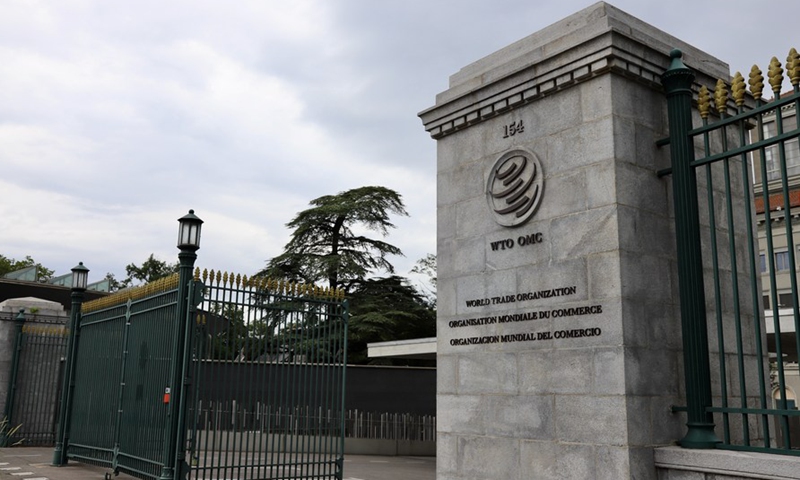

Photo taken on July 15, 2020 shows an exterior view of the World Trade Organization (WTO) headquarters in Geneva, Switzerland. (Photo by Li Ye/Xinhua)
China's 20 years of achievement and contribution since it joined the WTO have been tangible and remarkable, as it completely met its commitments to the WTO and will continue upholding the multilateral trading system even as protectionism and unilateralism rise across the globe, a spokesperson for China's Ministry of Commerce (MOFCOM) said on Thursday.
Saturday will mark the 20th anniversary of China's entry to the multilateral trade organization.
At a regular press conference in Beijing, MOFCOM spokesperson Gao Feng highlighted the results and tremendous changes that China had achieved and witnessed since it joined the WTO in 2001, reaffirming its commitment to the organization and promising to continue the country's opening-up process by shortening the negative list and improving the business climate.
"The Chinese government attaches great importance to and keeps its pledges, and it has fulfilled its commitments of WTO entry, which received sufficient recognition of the WTO director-general and members," Gao said.
The spokesperson also listed a series of figures to highlight China's achievements. China lowered its average import duty rate from 15.3 percent in 2001 to 7.4 percent in 2021, lower than its original promise of 9.8 percent when it joined the WTO, according to Gao.
Due to its vital role in global trade, China has been compressing the customs clearance time of foreign trade goods. It now usually takes 36.7 hours for imports to be cleared at Chinese customs, down 62.3 percent compared with 2017. Export clearance usually takes 1.8 hours, down 85.2 percent compared with 2017.
Meanwhile, thanks to the 19 free trade deals China has signed with 26 countries and regions, as well as the building of free trade zones, the customs clearance procedure, customs declaration efficiency and cross-border logistics have been greatly improved, Gao said.
"The most impressive achievement of China's entry to the WTO is the country's better-than-expected exports to the world," Tu Xinquan, dean of the China Institute for WTO Studies at the University of International Business and Economics in Beijing, told the Global Times on Thursday.
As the world's biggest exporter, China's share of world exports jumped from 4.3 percent to 14.7 percent over the past 20 years, Yi Xiaozhun, who served as the deputy director-general of the WTO in 2013, said in a forum in Beijing on Wednesday.
Before China joined the WTO, the country only had a role in the textile, shoe and wood sectors in the global market. Now, due to its strong manufacturing industry, made-in-China mechanical and electrical products, as well as cars and photovoltaic products, have all become competitive, Tu said.
"From the perspective of economic development, China's entry to the WTO improved the operational efficiency of the global economy as economical factors of production entered the markets, while reducing costs," Tu noted, adding that as China joined the WTO, the world economy enjoyed low inflation and high growth for years.
Also underscoring China's improving business climate, foreign direct investment (FDI) in China grew 157.7 percent from 2001 to 2020, the MOFCOM spokesperson noted, adding that annual FDI is expected to surpass 1 trillion yuan ($160 billion) this year.
"China has almost eliminated all restrictions on foreign investment in its manufacturing sector and it is loosening market access restrictions for foreign investment in agriculture, including the seed industry," he said.
Greater opening-up efforts are also taking place in finance, telecoms, construction, tourism and transportation sectors.





